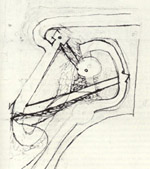Whitton Dean
A house for the Duke of Argyll's mistress
1738
The Land
Whitton Dean was originally an endship of Isleworth, one of three parishes comprising the Isleworth Hundred; Twickenham and Heston being the other two. Heston and Isleworth merged into the London borough of Hounslow, which was created in 1965 together with the Middlesex Urban District Councils of Brentford & Chiswick and Feltham. The London Borough of Richmond upon Thames was created at the same time to include the Municipal Borough of Twickenham together with Teddington, the Hamptons and Whitton. Since time immemorial a minor tributary of the Thames has formed the parish boundary separating Twickenham and Isleworth. About midway along its route is Murray Park, a ten and half acre pleasure ground in Whitton saved from the developers in 1914. A longstanding dispute, which came to a head and was the subject of an agreement between the parishes in 1439*, centred on a former lake drained before Domesday, which created an anomaly in the boundary. It was only by the twentieth century that all of this land came fully under Twickenham administration.
* Original in Guildhall Library, City of London, MS9171/4, 3rd Register (Prowst) at folio 87a of the Commissary of London

The House
In 1738, when Archibald Campbell, Lord Ilay, later 3rd Duke of Argyll was busy laying out his nearby estate, Whitton Park, he purchased some Whitton Dean land complete with a house and barn, from William Britton. Britton (sometimes Britain), described as a butcher of Twickenham, owned various properties and lands in Twickenham together with his wife Anne who had inherited Whitton property from her father, Thomas Grey in 1736 (LMA ACC1149/124, 125 & 126). One of the houses owned by Britton was in Sion Row, Twickenham.
Campbell demolished the old house, creating a new estate for his mistress, Mrs Elizabeth Anne Williams. The Palladian villa he built for her matched his own and encompassed many of the features earlier planned for Marble Hill House on the banks of the Thames in Twickenham. Here, Campbell had acted as agent for the Prince of Wales in acquiring land for the house, built as a settlement for his mistress, Henrietta Howard.
A later newspaper advertisement describes the 'elegant Italian Villa' at Whitton Dean complete with coach houses, stabling for twelve horses, riding house and numerous offices set in nine acres of beautifully wooded pleasure garden and grounds, and 31 acres of good pasture land.

John Rocque's Survey of 1741/6 shows the relationship between Whitton Park and Whitton Dean a short distance to the east. .

The latter is a winged mansion set within a walled enclosure facing west towards a small parterre garden and with the barn to its rear. What Rocque also shows immediately to the north is a garden, identified by Sir Roy Strong in 1993 as 'a lost formal garden' and one, 'clearly influenced by Alexander Pope'.

Although Pope spent much time devising garden schemes for Marble Hill, Charles Bridgeman eventually carried out the work. It has been suggested, however, from sketches for squiggly wilderness paths found amongst Pope's manuscripts that he was the author of a plan never implemented at Marble Hill, but remarkably similar to that at Whitton Dean. The garden was de-formalised, probably in 1797, when Humphrey Repton was commissioned to undertake landscaping work

The villa was demolished when the Gostling family came to live at Whitton Park in 1847. The Riding House became a drill hall for Colonel Murray's rifle volunteers and survived until 1935 when it was replaced with the present community hall. The offices, the lake and many fine trees disappeared that same year when a new road was built, adopting the altered name of Whitton Dene. Today a single mature cedar survives from the once grand avenue that led from the Duke's villa in Whitton Park to that of his mistress at Whitton Dean.
further reading:
Ed Harris, The Lost Garden of Whitton Dean, 2007
ACB Urwin, Birket's Brook, Borough of Twickenham Local History Society Paper No22, 1971
Chronology of the house
1736 William & Ann Britton
1738 Archibald Campbell, Earl of Ilay (1682-1761) later 3rd Duke of Argyll
'Pope-style' garden laid out
New house built
1740 Mrs Elizabeth Anne Williams, Ilay's mistress
1762 Colonel William Williams (Campbell)
by inheritance
1785 Jane Campbell by inheritance
1799 Archibald Campbell by inheritance
1800 Mrs Ashley
1802 Lady Petrie
1806 Francis Mackenzie
1811 James Campbell
1812 part of house, riding house etc.
1818 Colonel Archibald Napier
house, riding house etc.
1824 Mrs Napier
1827 house empty
1831 George Gostling 3rd (1777-1841)
purchased
1833 George Calvert, tenant
1841 Benjamin Gostling (1777-1843)
brother, by inheritance
1850 house probably demolished
1852 riding house, offices, gardens remain
1855 Lydia Gostling (1780-1859)
sister of George Gostling 3rd
1859 Maria Gostling (1785-1874)
daughter, George Gostling Jr.
1877 Col. Charles Gostling Murray (1825-1892)
drill hall / yard 8th volunteers
1914 Local authority purchase: Murray Park
1935 riding house, offices etc.cleared




